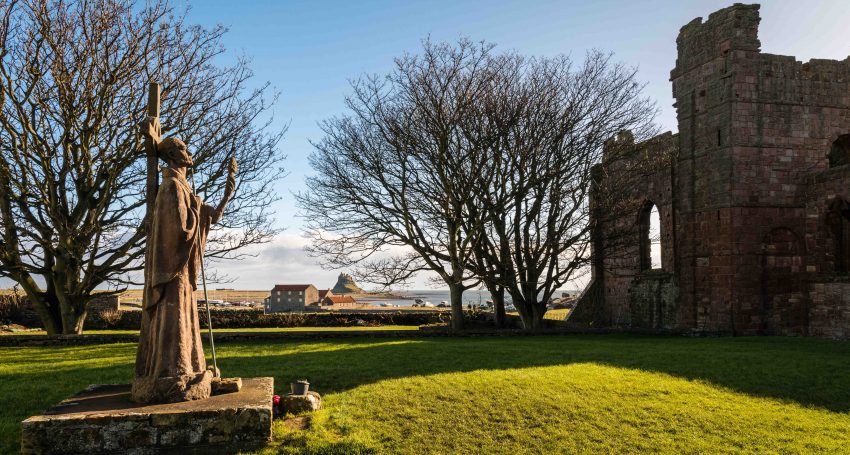The Origins of Anglicanism – what did the Romans, and Celts ever do for us?
Features
In the second part of her ‘Origins of Anglicanism’ series, The Rev’d Dr Josephine Inkpin from St Francis College explores what the Romans and Celts have contributed to Anglicanism: “In our understanding of Anglican history, we do well therefore to be open to ‘both/and’, rather than ‘either/or’ perspectives”

Beyond Monty Python – ‘both/and’, not ‘either/or’
In Monty Python’s Life of Brian, there is a powerful scene where a revolutionary sect asks, “What did the Romans ever do for us?” Recognition slowly dawns that the answer is actually “quite a bit!” When we truthfully explore the origins of the Ecclesia Anglicana we face similar acknowledgement for there are several influential strands which typically sit in paradoxical tension with one another. In our understanding of Anglican history, we do well therefore to be open to ‘both/and’, rather than ‘either/or’ perspectives. This is certainly apposite to the enduring influence of both ‘Roman‘ and ‘Celtic’ forms of early Christianity. Sometimes juxtaposed as two competing elements, each continues to shape the nature and dynamics of Anglican spirituality in distinct, but also complementary, ways. Indeed, recent scholarship even questions the terms ‘Roman’ and ‘Celtic’ (some preferring ‘Insular’ to ‘Celtic’) as a designator. It points out that the various early British and Irish Christian traditions were closely linked, rather than a simple, coherent, entity. Nor were ‘Celtic’ Christians isolated from others, as if in a form of spiritual Brexit (a problem with the alternative designation ‘Insular’). For, as Patrick Wormald put it: “One of the common misconceptions is that there was a Roman Church to which the Celtic Church was nationally opposed” in some rigid sense. Nonetheless, if we are generally wise to use inverted commas, historically they reflect enduring creative tensions between the local and universal, between Christ and culture, and between different emphases in mission, prayer and order. Appreciating this rich mosaic more fully enables greater depth in our vocation and spiritual life today.
Augustine and Columba
The year 597 CE marks a striking confluence of Roman and Celtic Christian traditions. At that point the Benedictine monk Augustine was sent as a missionary by Pope Gregory the Great. Sometimes known as ‘the Apostle to the English’, he became the first Archbishop of Canterbury. In the same year, the great Irish saint and missionary evangelist Columba died. Founder of the influential abbey of Iona, he had already helped nurture vibrant Christian faith in Britain, including in parts of northern England (through the work of Aidan and others based in Iona’s daughter abbey on Lindisfarne). As such, Augustine and Columba personally illuminate two founding myths of the Ecclesia Anglicana: the ‘Roman’, which emphasises episcopal direction and a striving for ordered unity and universality, and the ‘Celtic’, which accentuates communal and charismatic initiative and the affirmation of local diversity and indigeneity.
Creative tension?
As these two traditions engaged together, a number of conflicts were resolved at the Synod of Whitby in 664 CE, where various Celtic ecclesiastical practices (including a different calculation of the date of Easter and a distinct monastic tonsure) were brought in line with Rome. Yet, whilst ‘Catholicity’ was thus formally established, other creative aspects of ‘Celtic’ Christianity continued to form an important legacy for the Ecclesia Anglicana. Down the centuries, including at the Reformation, where distinctiveness from Rome was a crucial issue, ‘Celtic’ emphases have thus been reaffirmed for fresh inspiration. In recent decades this has indeed led to a fertile industry of scholarly research, inventive ‘rediscovery’ and creative ‘re-presentations’ of Celtic Christianity. To some degree, as Anglicans today wrestle with the challenges of our own times, they too replay ‘Roman’ and ‘Celtic’ tensions in new ways. What kinds of mission and order, relationships to culture and context, autonomy and mutuality, unity and diversity, do we require today?
Advertisement
The ‘Roman’ or ‘Canterbury’ tradition
A healthy, historically-informed, approach would seek to draw from both ‘Roman’ and ‘Celtic’ features of the Anglican tradition, having appropriate appreciation of both and avoiding exaggeration of the ‘other’, for each have continuing relevance. The ‘Roman’ themes and trajectories within Anglicanism are certainly critical both to Anglican sustainability and unity and to relationships with the wider Christian church and world. Consider, for example, the following three key features of the ‘Roman’ tradition – or, Anglicans might better say, the ‘Canterbury’ trajectory (as represented by Augustine): catholicity and universality, common order and missional resourcing and vision.
Catholicity and universality
Firstly, the ‘Canterbury’ trajectory places important emphasis on the catholic and universal orientation of Christian faith. This both guards Christian community against the potential excesses of local action and, more positively, enables continuing vital relationship with other Christians beyond our immediate geographical, communal, or other, particular identities.
Common order
Secondly, the ‘Roman’, or ‘Canterbury’, traditions within Anglicanism preserve and engender coherent and constructive elements of common order. Indeed, if we look for the origins of so much of our Anglican structures, liturgical forms, creeds and calendar, they lie back in this early Church era, shaped by terminology and other features adapted from Graeco-Roman culture. In the contemporary and post-colonial world, such elements may need fresh enculturation, yet they also provide essential memory, continuity, and frameworks for growth.
Advertisement
Missional resourcing and vision
Thirdly, when we reflect upon the challenges of mission today, this trajectory of historic faith encourages the recognition and application of wider resources. Augustine’s mission was founded as Gregory looked beyond the immediate and as it drew on support from the wider Church. Similarly, Anglican mission today requires generous, shared, and imaginative commitments, particularly in the face of challenging circumstances of poverty, marginalisation and oppression. The story is told that Pope Gregory was inspired to send Augustine by meeting fair-skinned slaves being sold in the market-place in Rome. Asking who they were, he was told they were “Angli” (English). “Surely not Angli”, Gregory is said to have replied, “but Angeli (angels)”. For the historic ‘Roman’ or ‘Canterbury’ themes and trajectories are not about good order and communication alone. They are, at their depth, about facilitating good order and fruitful relationships to enable such beatific vision and its expression.
The ‘Celtic’ trajectory
In complementary contrast, the ‘Celtic’ features of historic Anglicanism offer other elements of vital spiritual strength. This is reflected in their influence across the Anglican world, including within the Anglican Church Southern Queensland, where several churches, schools, and other elements are dedicated to Celtic saints such as Aidan, Hilda, and Columba. Perhaps because of the character of ‘modern’ Australia’s foundations – particularly the conflict between English-dominated authorities and Irish Catholic convicts, and between the strong early Church of Ireland influences and Irish Catholicism in Sydney – Celtic Christian elements have sometimes been viewed with suspicion in some Anglican quarters. It is striking, for example, that Brigid is not honoured in the Australian Anglican calendar, despite being the greatest of all Celtic female saints, and, with Patrick, the greatest of all Irish saints. Whilst there are wonderful exceptions, features such as Celtic crosses are also not so prominent in Australian Anglicanism as among its British counterparts, perhaps because they are associated by some with Roman Catholicism and even paganism. Yet ‘Celtic’ influences are most valuable for our times.
A word of warning – beware romanticism!
‘Celtic Christianity’ is easily romanticised. As mentioned earlier, its historical realities can be distorted, and, in recent times, some, for their own purposes, have tried to reconstruct it in as an ancient ‘New Age’ spirituality, as a more progressive or even ‘Buddhist-like’ Christianity, or as a more vibrant and independent expression of faith shorn of institutional baggage. This does violence to a diverse phenomenon, which not only shared early Christian orthodoxy of belief, but which was always closely connected to the wider, universal Church, not least the eastern Church with which it also shares some interesting features (particularly in its monastic traditions). What it actually offers today is different, but nonetheless vital: the sacredness of place, people and particularity; transcending binary boundaries; and, ‘horizontal’ mission through ‘active-contemplative’ lives and communities.
The sacredness of place, people and particularity
Firstly, a powerful ‘Celtic’ characteristic is to affirm the sacredness of place, people and particularity. This not only balances the tendency of universalist notions of faith to blur, or obliterate, the gifts of diversity in God’s creation and story. It also, reflecting strong contemplative awareness, pays due attention to the presence of God in the ‘everyday’, in every moment, ‘heaven in ordinary’. ‘Celtic’ prayers were thus created for all matters of life, from milking a cow to pregnancy and childbirth. Some of this thereby finds its way into Anglican liturgy, in its seasonal prayers and rhythms, Rogation, harvest and other events. In doing so, the ‘Celtic’ tradition created bridges between Christianity and the world of the countryside, for the early Church in its ‘Roman’ formulation was very much an urban phenomenon. Its further growth was considerably dependent on such reconnection of God with the land and its people, rediscovering these important biblical themes. In an even more radically urbanised world today, which so undervalues and undermines the wider creation, such ecologically connected spirituality is therefore a vital gift to us. Indeed, in places such as Australia, where Christian faith has too often been an external import rather than more fully contexualised, ‘Celtic’ Christianity perhaps offers a bridge for ‘white fellas’ into receiving the gifts of Indigenous people and the particularities of Christ’s presence in the land itself.
Transcending binary boundaries
A second strong ‘Celtic’ spiritual characteristic is the transcending of simplistic and easily assumed binary boundaries. ‘Roman’ and ‘Canterbury’ trajectories are strong on law, which can set helpful limits and guidelines. However, the danger of legalism is always present. What the great Irish philosopher-priest-poet John O’Donohue called the ‘Celtic Imagination’ offers other dimensions. Celtic saints for instance had a very strong sense of the power of sin and evil: compare ‘St Patrick’s Breastplate’ as a striking example. Yet they also typically affirmed the goodness of Creation and God’s grace in all things. They were therefore wary of crude separation of the natural from the supernatural, darkness from light, death from life, earth from heaven, humanity from divinity, male from female. Not for nothing then do we find, for example, strong female leadership among ‘Celtic’ Christians, such of that of the formidable St Hilda who presided over a double monastery of men and women at Whitby. Again, perhaps this call to see divinity in ’both/and’ rather than ‘either/or’ is a particular gift to treasure and use in our age of often strident and divisive identities.
‘Horizontal’ mission through ‘active-contemplative’ lives and communities
Thirdly, ‘Celtic’ Christianity offers us refreshing models of mission which are more ‘horizontal’, communitarian, and contemplative than some others we inherit. Again at the risk of simplifying, the ‘Roman’ and ‘Canterbury’ models tend towards the ‘vertical’, led or initiated by bishops, as in the example of Augustine and Gregory. This often provides effective direction, support and coherence. ‘Celtic’ Christian growth, however, frequently resulted from care and evangelism emerging from specific local communities, notably monasteries, which acted as local, flexible, action-contemplation centres of light, learning and life. Once more, it is important to stress that these were not historical opposites, nor are they strict alternatives. Yet they remind us that fruitful mission and evangelism can take different forms with different structures, in the same way as the more ‘vertical’ examples of ABM and ‘horizontal’ examples of CMS developed in the modern era and have thrived positively alongside one another.
Related Story
 Features
Features
The Origins of Anglicanism – what difference did Henry VIII actually make?
‘In God, we live and move and have our being’, whoever and wherever we are
In exploring the early centuries of the Ecclesia Anglicana, we are therefore brought to a realisation of the complexity of Anglican origins, and of the way in which such historical features can be life-giving to us today, provided we heed the temptation not to read our own divisions into the past, treating them rather on their own merits. As a child of St Aidan’s Northumbria, with other strong ‘Celtic’ influences, I also own myself as a child of Canterbury, grateful also for the positive fruits of that trajectory. For, as Aidan expressed it, in the beautiful prayer attributed to him, whilst we need to find our own space and gifts in God, we are also bound together: just as the ‘Celtic’ Holy Island of Lindisfarne is particular in its sacredness, yet bound to both sea and mainland. For ultimately, all comes from, and thrives in, God.
Prayer of St Aidan
Leave me alone with God as much as may be.
As the tide draws the waters close in upon the shore,
Make me an island, set apart,
alone with you, God, holy to you.
Then with the turning of the tide
prepare me to carry your presence to the busy world beyond,
the world that rushes in on me
till the waters come again and fold me back to you.







